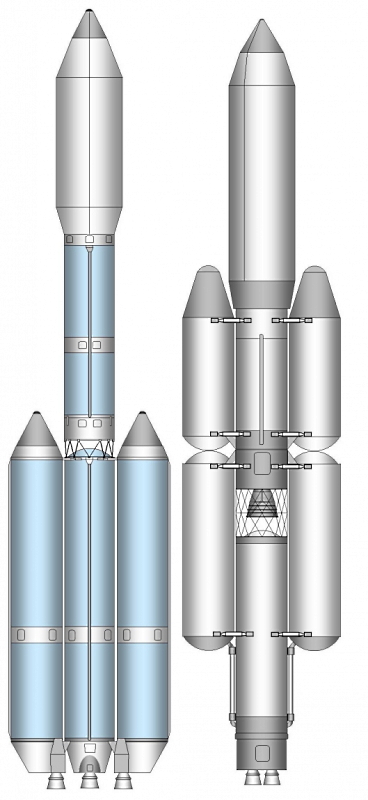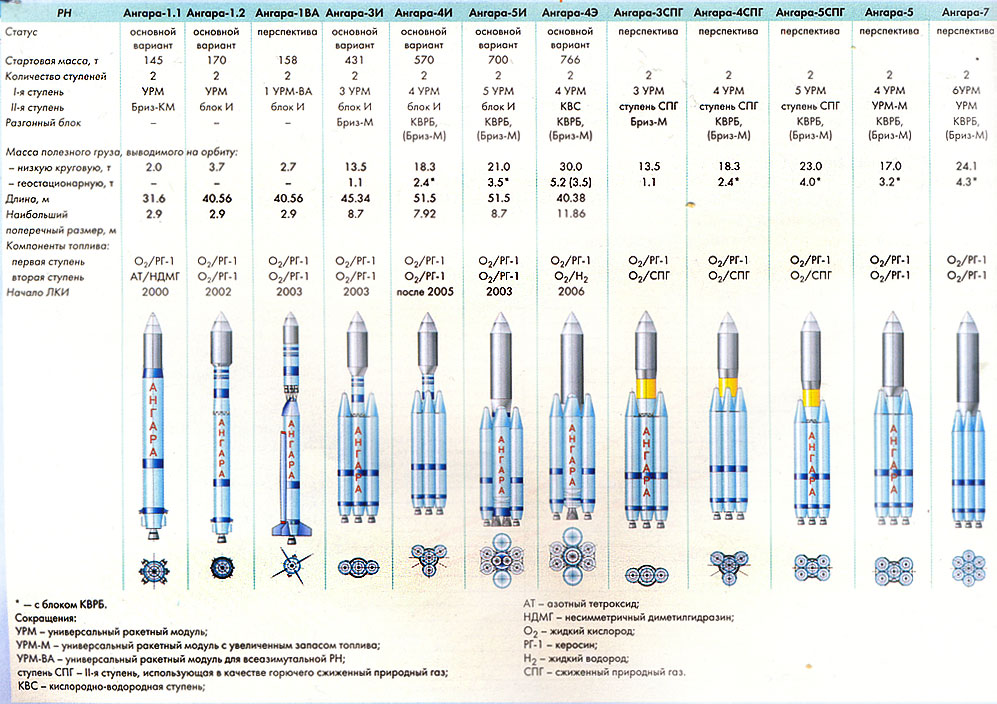
"Angara-A5" in the assembly and testing complex, photo of the Ministry of Defense of the Russian Federation
Crawl quietly, snail, on the Fuji slope
The history of "Angara" gives rise to mixed feelings: rational decisions and working ideas are crushed by the lack of funds and the unimaginably slow speed of the project. After the collapse of the USSR, Baikonur ended up in independent Kazakhstan, the political prospects for relations between the newly formed countries were unclear, and the situation at the cosmodrome itself was disastrous (see, for example, the history of the riot of soldiers-construction battalions in February 1992 with burnt barracks and several corpses). Under such conditions, the country needed a new rocket capable of launching from Russian spaceports and, ideally, better than the Proton. Many rocket-building enterprises took part in the competition, and two projects from RSC Energia and GKNPTs im. Khrunichev.

On the left is a variant of the RKKE, on the right is the State Research and Production Center named after Khrunichev, drawing by D. Vorontsov
The competition was won by the "eared" "Angara" for completely rational reasons - in Plesetsk the launch pad for the "Zenith" launch vehicle was almost ready, into which the "Angara" was installed with minimal modifications. And there was no money for a large-scale construction. And for all the unusual layout, it had its advantages - the rocket was transported without problems by rail, the low height simplified the design of the pipelines and eliminated the difficulties with damping longitudinal vibrations or inter-tank compartments. And the second stage favorably differed in the use of an oxygen-hydrogen fuel pair and an RD-0120 engine, with which they seemed to have not forgotten how to work after Energia. In 1995, the RF Government issued a decree on the creation of a rocket with the first launch in 2005, but the project was buried by a combination of factors - on the one hand,with Kazakhstan more or less managed to improve relations, "Protons" began to carry out commercial launches, being very cheap on the international market, and there was still no money to develop a new rocket.
The next chapter of the story began in the second half of the nineties. RD-0120 and hydrogen still passed into the category of artifacts of a developed civilization of the past, so that the rocket became completely oxygen-kerosene. But the idea of a modular rocket appeared. If you develop a universal rocket module, then, having selected the required number of them, you can assemble a rocket of the required carrying capacity. And for the new rocket, the size of the module was chosen so that one URM would replace the light missiles "Cosmos-3" and "Cyclone-3" (which had problems with cooperation between the former Soviet republics, and the lack of using toxic fuel), three URM replaced "Zenith" (also torn between countries), and five URM - "Proton". At the same time, the rocket could in no way be a direct competitor to the Soyuz - for a similar carrying capacity, two URMs would be needed,which would require a heavy and ugly second stage adapter. And if you open the Novosti Kosmonavtiki magazine for 1999, you can see the familiar shape of the Angara and the absolutely incredible dates of the first launches in 2000.

"News of Cosmonautics" August 1998 - February 1999
Please note that such fashionable ideas as liquefied natural gas and even the reusable first stage are already mentioned there. And, as practice has shown, the idea of a modular rocket turned out to be quite workable - in the 2000s it was confirmed by Delta IV Medium / Heavy, and in tenths - by Falcon 9 / Heavy. Now, possessing an afterthought, it seems that the modules should have been made in a dimension slightly heavier than the Zenith - the Soyuz-2.1v occupied the niche of light missiles, and many years later the Zenit dimension was chosen for Soyuz-5. But without magic information from the future, the choice seemed rational, and the story of how Musk almost began to build a potentially much less successful Falcon 5 on the market is very well known.
It is difficult to say how the fate of the rocket would have developed if it had first flown in the 2000s. In real history, a black hole begins further - the dates move further and further. In an interview with the General Director of GKNPTs im. Khrunichev to the magazine "Science and Life" in 2004, the year of the first launch is called 2005. In 2004, a contract was signed with South Korea to create a rocket called "Naro-1" and using the URM from "Angara" as the first stage. In 2007, Rossiyskaya Gazeta quoted First Deputy Prime Minister Sergei Ivanov:
There will be no revision of the dates. Flight design tests "Angara" should begin in 2010, and the first launches - in 2011
In 2008 GKNPTs them. Khrunichev pleased the public with photographs of preparations for fire tests of the URM-2. Naro-1 was first launched in 2009, and the Russian first stage worked without comment, so the URM-1 was almost ready ( final tests were also successfully carried out in November ), but Angara was still far beyond the horizon. In 2010, "due to problems with financing," the first launch has moved already in 2012. And in 2011 came the news of the transfer of missile production in Omsk. In 2012, called the timing of sending the light rocket to the launch site "Plesetsk" - December 2012, heavy - 2013. However, the light rocket went to the launch site in May 2013 and the heavy -in July 2014 . A light rocket in a special modification 1.2PP successfully flew along a suborbital trajectory on July 9, 2014, and a heavy one launched a payload model into geostationary orbit on December 23, 2014. Well, then the effect of moving production to Omsk began, which the proverb equates to two fires. In 2015, TASS reports on plans to launch one heavy "Angara" produced in 16-17 years, no production in 16-17 years and the resumption of production from 2018. In 2018, the second heavy "Angara" was promised to be built by 2019, but at 19 the dates have shiftedfor 2020, during which we smoothly reached December. The rocket is already at the launch site, and if the troubles it detects remain minor, chances are it will return to flying this month. So far, two launches of the heavy Angara are planned for 2021, not earlier than the second half of the year, and future plans even include a commercial launch of the light version 1.2 in the fall of 2021 with the Kompsat-6 satellite, a contract for which was signed by the launch services provider ILS in 2016 ...
What will you be
Today, regardless of whether Angara is being criticized or praised, it has no alternatives in solving certain tasks, the main of which is the launch of payloads into geostationary orbit. The logic here is very simple. It is impossible to return to Proton - the rocket has only one launch site at Baikonur, and the use of toxic propellants is not even bad in itself, but because it is an excellent reason for Kazakhstan to ban missile launches in the event of a deterioration in relations. There have already been cases in history when Kazakhstan prohibited the launches of "Protons", and the "Antiheptil" movement operates in the country .calling for a ban on "environmental genocide". The Soyuz-5 / Irtysh, which is currently being developed, is at the design stage, the first launch is expected not earlier than 2024, which, according to the Angara experience, with a nonzero probability may mean “unknown when”. The possibility of launching satellites into a geostationary orbit is not the kind of competence that an independent developed country can afford to lose - the days of naive hopes of the 90s “why do your own, it’s easier to buy better and cheaper abroad” are long gone, because it very quickly became clear that “foreign friends ”(regardless of whether they are from the West or from the East) are not friends, but stakeholders with their own interests. And the purchase of launch services for military and state satellites will not only be expensive, but will hang in the balance of relations between countries,when any disagreement can lead to the loss of the ability to start your device at all.
Today, in the degree of readiness that Angara is in, it has two options for the future - normal and excellent. In the "normal" version, it will launch several times a year, launching state payloads - military communications "Blagovest", navigation "GLONASS", meteorological, communications and scientific vehicles. And this will continue until a better and cheaper Russian rocket appears, most likely at least ten years. In the “excellent” version, the measures taken to reduce the cost of production (and, possibly, the next fall in the ruble exchange rate will help) will make the rocket at least to some extent competitive, and, in addition to the state, there will also be commercial loads on it. And, finally, Angara can serve another very important goal - the revival of hydrogen technologies.If it turns out to create the "-A5B" variant with a hydrogen third stage and an upper stage, engineers will appear in the country with competence acquired very late in the USSR and practically lost in the 90s.
It is not known whether onboard cameras will be installed on the rocket, in 2014 they did not. If not, then it will be possible to see the beautiful "Medvedev's cross" of the separation of four blocks of the first stage only in the simulator.